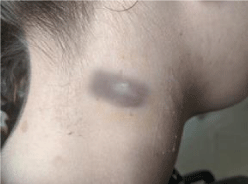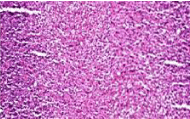Lymphadenopathy of Kikuchi-Fujimoto: Unusual Case Report?
Zouhair Najib*, Hammouda Yassir, Oukessou Youssef, Rouadi Sami, Abada Redallah Laarabi, Roubal Mohamed and Mahtar Mohamed
Department of ENT, Hospital 20 August, University Hassan II, Casablanca, Morocco
*Address for Correspondence: Zouhair Najib, Department of ENT, Hospital 20 August, University Hassan II, Casablanca, Morocco, Tel: +002-126-563-927-75; E-mail: [email protected]
Submitted: 19 September 2020; Approved: 23 September 2020; Published: 25 September 2020
Citation this article: Najib Z, Yassir H, Youssef O, Sami R, Laarabi AR, et al. Lymphadenopathy of Kikuchi-Fujimoto: Unusual Case Report. Int J Case Rep Short Rev. 2020; 6(9): 060-00. https://dx.doi.org/10.37871/ijcrsr.id85
Copyright: © 2020 Najib Z, et al. This is an open access article distributed under the Creative Commons Attribution License, which permits unrestricted use, distribution, and reproduction in any medium, provided the original work is properly cited
Keywords: Kikuchi-Fujimoto disease; Histiocytic necrotizing lymphadenitis; Adenopathies
Download Fulltext PDF
Kikuchi-Fujimoto Disease or histiocytic necrotizing lymphadenitis is a rare cause of benign cervical adenopathies. It is an anatomoclinic entity of unknown cause. Diagnosis is based on histologic examination of the lymph nodes. Patient’s evolution is generally favorable with spontaneous healing after a few weeks. We here report the case of a 20-year old woman presenting with cervical lymphadenopathy associated with fever. Cervical lymph node biopsy showed Kikuchi-Fujimoto disease. Patient’s evolution was marked by regression of adenopathies without receiving any treatment.
Introduction
Kikuchi Fujimoto Disease (KFD) is an uncommon benign condition of necrotizing histiocytic lymphadenitis commonly seen in East Asian and Japanese populations [1]. It is first reported in Japan by Kikuchi [1] and Fujimoto [2] in 1972. Because of its shared clinical features, the disease can be easily mistaken for other forms of lymphadenitis with a misdiagnosis rate up to 40% [3]. Although many bacteria, viruses, and autoimmune conditions were attributed to its etiopathogenesis, none of these were consistently associated with the condition [4]. Diagnosis of KFD is based on histopathological studies of the involved lymph nodes [5]. We report the case of a young 20-year-old woman diagnosed with KFD.
Case Report
A 20-year-old woman, presented with history of fever within one month and latero-cervical lymphnod. She was generally healthy and fit. She has no respiratory symptoms. Clinical examination showed multiple cervical lymphnods the most important one was firm, measuring about 2 cm in diameter, mobile, painless and associated with local inflammatory signs. There was no local infectious focus in otorhinolaryngologic area. Temperature was around 39°C (Figure 1).
Biological study showed hyperleucocytosis at 17400, the C Reactif Protein was normal at 3.5, research of BK in expectorations was negative on direct examination and culture. The intradermoreaction to the tuberculin was positive at 12 mm. Serology of virus hepatitis B, C etc. HIV were negative, cytobacteriologic study of urines was negative.
Thoracique CT scan showed mediastinal lymphnods. Cervical echography showed multiples lymphnods of left jugulocarotidiens and spinals lymphnods with a diameter of 6-5 mm.
Pathological examination showed necrotizing histiocytic lymphadenitis Kikuchi type, a normal and generally preserved architecture with the presence of numerous foci of more or less extensive necrosis sometimes bordered by spumous histiocytes accompanied by slightly atypical immunoblastic cells, without neutrophilic polymorphonuclear cells or plasma cells (Figure 2).
Therapeutic management was limited to surveillance. The evolution was marked by clinical and radiological improvement without recurrence with a 3-years follow-up.
Discussion
Kikuchi-Fujimoto Disease, or histiocytic necrotizing lymphadenitis, was described in 1972 simultaneously by two Japanese physicians, Kikuchi and Fujimoto [6]. The neck is the site of predilection of Kikuchi-Fujimoto disease [7].
In 1972 Dr Masahiro Kikuchi and Dr Fujimoto presented two cases of lymphadenitis showing focal reticulum cell hyperplasia with nuclear debris and phagocytosis separately [6,7]. This disease is more prevalent in Asia, particularly in Japan, although the geographical and ethnic correlation has not been clearly explained. Some authors have reported that HLA class II alleles (DPA101 and DPB102), which are more frequent in Asian populations, are associated with Kikuchi-Fujimoto disease [6,8]. This disease affects young subjects under the age of 40 years with a mean age of onset of 21 years and a female predominance [6,9].
The definitive diagnosis of KFD is made through lymph node excision biopsy and histological examination. The diagnosis of Kikuchi-Fujimoto disease is based on histological examination of a lymph node biopsy. Macroscopic examination of the lymph node section may reveal yellowish zones of necrosis. Microscopically, the lymph node architecture is partially preserved and 3 forms may be observed. Necrotic form (more than 50% of cases), proliferative form (30%) and xanthogranulomatous form (< 20%) [6-9]. However, it is a challenge for the pathologist to differentiate it from SLE, lymphoma, drug -induced lymphadenopathy, or Kawasaki disease.
Kikuchi-Fujimoto Disease resolves spontaneously over several weeks in the majority of cases [6], but deaths have been observed in systemic forms of the disease [7]. KFD is a subacute disease, mostly lasting 1 to 3 months, but some persisting for up to 1 year [10]. There is no universally agreed treatment plan as each case could be somehow different. The primary treatment of KFD is to manage the disease by supporting the patient mentally and physically to speed-up the relief of the symptoms. Antibiotics are not effective, however, their use in this case [11] is to avoid potential bacterial infections. The use of hormone-related drugs can relieve the symptoms and shorten the course of the disease. Prednisone was used as an effective treatment for pregnant women [12]. Generally, KFD is a benign and self-limiting disorder, so a short inpatient stay with symptomatic treatment (as in our case) generally suffice. However, for patients with significant systemic symptoms (e.g. multiple organ systems failure or immune system dysfunction), appropriate drugs such as Non-Steroidal Anti-Inflammatory drugs (NSAIDs), hormones and immunosuppressants should be seriously considered to manage the symptoms while further specific diagnosis are to be carried out.
To understand the disease and improve its diagnosis, it is crucial to have a comparative review of various aspects relating to the disease. We surveyed the literature on KFD and compared our case with some of those reported recently on the key aspects, including sex, age, ethnic origin, symptom and treatment (Table 1).
Conclusion
Kikuchi-Fujimoto Disease is a relatively rare, but probably underestimated cause of lymphadenopathy in young adults. Confirmation of the diagnosis is based on histological examination of a lymphnode biopsy, particularly immunohistochemistry. Kikuchi-Fujimoto disease usually has a spontaneously favorable clinical course. These patients require prolonged follow-up due to the risk of subsequent onset of an autoimmune disease, especially systemic lupus erythematosus.
- Kikuchi M. Lymphadenitis showing focal reticulum cell hyperplasia with nuclear debris and phagocytosis. Nippon Ketsueki Gakkai Zasshi. 1972; 35: 379-380.
- Fujimoto Y, Kozima Y, Yamaguchi K. Cervical subacute necrotizing lymphadenitis. A new clinicopathological agent. Naika. 1972; 20: 920-927.
- Ramirez AL, Johnson J, Murr AH. Kikuchi-Fujimoto’s disease: An easily misdiagnosed clinical entity. Otolaryngol Head Neck Surg. 2001; 125: 651-653.
- Heikens J, Tel W, van de Stadt J, de Koning J, Ten Napel CHH. Kikuchi’s lymphadenitis: Report of a Yersinia enterocolitica-associated case and an overview of aetiology and clinical outcome. Neth J Med. 1992; 41: 222-228.
- Bennie MJ, Bowles KM, Rankin SC. Necrotizing cervical lymphadenopathy caused by Kikuchi-Fujimoto disease. Br J Radiol. 2003; 76: 656-658. DOI: 10.1259/bjr/67899714
- Viallard JF, Parrens M, Lazaro E, Caubet O, Pellegrin JL. Necrotizing histiocytic lymphadenitis or Kikuchi-Fujimoto disease. Presse Med. 2007; 36: 1683-1693. https://bit.ly/2RQzFG3
- Astudillo L. Kikuchi-Fujimoto disease. Rev Med Interne. 2010; 31: 757-765.
- Moinet F, Polomat K, Bomahou C, Boutrou M, Duflo S, Molinie V, et al. Kikuchi disease: Epidemiology in Martinique and characteristics in an afrocaribean population. Rev Med Interne. 2014; 35: 29
- Adjaoud D, Boudjemaa S, Boccon-Gibod L, Leverger G. Kikuchi-Fujimoto's disease: Report of 5 cases and literature review. 2007; 14: 1333-1336. DOI: 10.1016/j.arcped.2007.07.015
- Lin HC, Su CY, Huang CC, Hwang CF, Chien CY. Kikuchi’s disease: A review and analysis of 61 cases. Otolaryngol Head Neck Surg. 2003; 128: 650-653. DOI: 10.1016/s0194-5998(02)23291-x
- Humphreys S, Oikonomou KG, Ward N, Aye M. Kikuchi disease: The great Masquerador - a case report and review of the literature. Med Case Reports. 2018; 4: 1-4. https://bit.ly/2HqGyfi
- Altuntas F, Sari I, Canoz O, Yildiz O, Eser B, Cetin M, et al. Kikuchi-Fujimoto disease: A rare but important cause of fever and lymphadenopathy in pregnant women. Am J Hematol. 2006; 81: 118-120. DOI: 10.1002/ajh.20495
- Shenjie Xu, Weilian Sun, Jiamei Liu. Kikuchi-Fujimoto disease: A case report and the evaluation of diagnostic procedures. BMC Oral Health. 2019; 19: 223. https://bit.ly/360t4kL
- Kharoubi S. Kikuchi Fujimoto, one case report and review of the literature. Rev Laryngol Otol Rhinol (Bord). 2008; 136: 125-128. https://bit.ly/3cq2jY2
- Mamun AM, Biswas RP. Kikuchi’s Disease in a Young Female-A Case Report. J Gen Pract. 2013; 1: 1-2. DOI: 10.4172/2329-9126.1000130
- Lame CA, Loum B, Fall AK, Cucherousset J, Ndiaye AR. Kikuchi-Fujimoto disease, a rare cause of lymphadenopathy in Africa. Description of the first case in Senegal and review of the literature. Eur Ann Otorhinolaryngol Head Neck Dis. 2017; 134: 347-349. DOI: 10.1016/j.anorl.2017.02.007



Sign up for Article Alerts